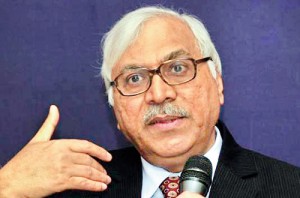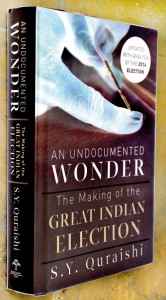Sunday Times 2
For forms of elections let fools contest
Man is nasty, society is chaotic and politics is nothing but a struggle for power. What turns disorder into order is democracy complete with the rule of law and a bill of rights, although it is said democracy is the worst form of government, except for all the others.
Democracy is nothing without universal adult franchise or elections. But like all forms of democracy, all forms of elections are fraught with flaws. Hence the never-ending debate over the best form of elections — whether it is the first-past-the-post system or the proportional representation system or a mix of the two in various ratios. For forms of elections let fools contest, whatever is best administered is best.

S.Y. Quraishi: India’s elections, like the Taj Mahal, are a world wonder
If this is the criterion, India’s election machinery is amazing and those who administer the elections stand out for their commitment and integrity. India’s elections may not have tourism value like the Taj Mahal, although moves are now underway to promote election tourism. Yet they can easily be described as one of the world’s wonders. How the Elections Commission of India (ECI) conducts elections offers valuable lessons to politicians and political science students, academics and activists, democracy lovers and dictators, lawmakers and lawbreakers, and, above all, to elections commissioners worldwide and their staff.
All systems go
Described by many observers as The Greatest Show on Earth, India’s elections mean all systems go: Even bulls, mules, camels and elephants and trains, buses, tractors and aircraft are brought into service when the world’s largest democracy with a voting population of more than 850 million goes to poll. Also put into service are more than 1.4 million electronic voting machines, 11 million polls staff, nearly 850,000 polling stations countrywide, 2.5 million security personnel, nearly 150,000 observers and 75,000 videographers carrying some 40,000 digital cameras. All this is part of the gigantic effort by the ECI to ensure that the people’s right to elect their government is upheld.
It is indeed a title befitting the subject matter when S.Y. Quraishi, easily one of India’s most remarkable Elections Commissioners, calls his book “An Undocumented Wonder: The Making of the Great Indian Election” – which is the subject of this review.
I have little doubt that readers would thank him for producing a brilliant book in simple yet scholarly language and helping them to marvel at the Himalayan task — the working of India’s elections machinery — and the challenges the ECI and its staff encounter. Theirs is an all-out war to ensure that every voter exercises his or her franchise and that every vote is counted. They plan and war-game moves to defeat attempts by insurgents and Naxalites in troubled regions to disrupt the elections — and also attempts by moneyed, corrupt and power-hungry politicians to distort the will of the people.
Mr. Quraishi’s book, an insider’s account, is a must-read for Sri Lankans especially at a time when the country is set on a good-governance mode and when moves are underway to provide constitutional guarantees to the independence of the Elections Commission through the 19th Amendment. The people of Sri Lanka have witnessed how helpless our elections commissioners have been in carrying out their duties. Often our  elections commissioners had or are alleged to have succumbed to pressure from powerful politicians of the party in power. Perhaps the exception is the incumbent Elections Commissioner, Mahinda Deshapriya, who with limited powers and resources withstood political pressure and ensured a relatively fair election that changed the history of this country. The cause for Mr. Deshapriya’s triumph, perhaps, lies in his commitment to ensure that the will of the people was not thwarted by the scheming of dishonest politicians. He emerged like his counterparts in India — the Quraishis and the T.N. Sheshans. Incidentally, Mr. Quraishi, who was India’s Chief Elections Commissioner from 2006 to 2012, was in Sri Lanka during the January 8 election as head of the Asian Elections Authorities on a monitoring mission.
elections commissioners had or are alleged to have succumbed to pressure from powerful politicians of the party in power. Perhaps the exception is the incumbent Elections Commissioner, Mahinda Deshapriya, who with limited powers and resources withstood political pressure and ensured a relatively fair election that changed the history of this country. The cause for Mr. Deshapriya’s triumph, perhaps, lies in his commitment to ensure that the will of the people was not thwarted by the scheming of dishonest politicians. He emerged like his counterparts in India — the Quraishis and the T.N. Sheshans. Incidentally, Mr. Quraishi, who was India’s Chief Elections Commissioner from 2006 to 2012, was in Sri Lanka during the January 8 election as head of the Asian Elections Authorities on a monitoring mission.
Running through his 448-page book and binding the chapters and ideas together is the good intention with which India’s elections commissioners work as the custodians of democracy and the guardians of the sovereignty of the people. Its chapters deal with the evolution of the good intention – the process of learning from mistakes, the nuts and bolts of electoral operations to money power and the role of the media, and the role of the youth, to name a few topics. Every chapter gives readers a wealth of knowledge not only about elections but many aspects of political life from voter behaviour to political skullduggery, from ancient forms of Indian democracy — the Buddha’s discourse and the tenth century Tamil Nadu democracy — to modern reforms. There are interesting anecdotes and tidbits aplenty. They together with other useful techniques remove reader fatigue associated with books on serious subjects.
But his is a book that makes one read, think and act. The book, which tells the reader many things about the first Indian general election in 1951-52, the last general election in 2014 and many polls before and in between, notes that most politicians are thieves but asks: “Can democracy exist without politicians?” This is where the ECI steps in to conduct a free and fair election, the credibility of which rests on four pillars — the independence or the fearlessness of the elections commission (leaving no room for incumbency advantage), transparency, neutrality and professionalism.
Mr. Quraishi’s erudite analysis identifies four major trends in Indian politics – the decline of a dominant pan-national party, the emergence of regional parties in a national role, multi-party coalition politics and the ethnicisation of political culture with each party claiming and surviving on sectarian support. He also notes the increasingly assertive role being played by civil society in strengthening India’s democracy.
Money politics and media
The book deals extensively with the ECI’s battles to deal with the role of money in subverting elections. Targeted are not only power-hungry politicians — but also Corporate India. An electoral democracy cannot function without political finance, which comes with strings attached and quid-pro-quo deals. Money power at elections makes voters a commodity, undermining the essence of democracy. The unscrupulous politician knows how to bypass laws and heap freebies on the voter. While more regulation is called for, civil society action can again play a major role to defeat money power. The chapter on ‘Engaging Youth’, to a great extent, offers a solution to the problem of money in politics. This chapter relates the story of a university student who travelled more than 5,500 kms – 3,200 of this distance on foot — to empower India’s poverty-stricken voters. Abdul Mujeeb Khan asks them what things are like. They tell him life is difficult and the government is not doing enough for them. He then asks how they usually choose who they are going to vote for. Most times, the answer is whichever candidate gives them the largest handout, money, or liquor. Mujeeb Khan then asks: “If you vote for somebody because of the money he pays you, then do you really expect the politician to not make money in return? After all, he has to recoup his investment.”
The chapter on the media makes interesting reading and Mr. Quraishi’s views on regulation of the media during election time are relevant to Sri Lanka since the 19th Amendment provisions on the Elections Commissioner’s powers to appoint a competent authority to govern ‘unruly’ media organisations have created some controversy.
“Whereas much of the mass media in India covered the elections in a non-partisan manner, there were sections that compromised their independence for commercial interests. …. We in the Commission were clear that while there should be no move to curtail the freedom and independence of the media, and that self-regulation is ideally the best form of regulation, effective steps to prevent the misuse of the media by vested interests are indeed required,” he says.
He also sees the media as the eyes and ears of the ECI during elections time and the foot soldiers of the commission have been told to take every report in the media seriously and follow them up with necessary action.
Adding value to the book is the foreword written by Gopalkrishna Gandhi. He says Quraishi, a development thinker, “has not just given us information and knowledge, but confidence and pride.”
When reading this book, a tale of courage and hope, a Sri Lankan reader may ask: “When will we see systems that will make us proud again.”
Book facts
Title: An Undocumented Wonder: The Making of the Great Indian Election
Author: S.Y. Quraishi
Publisher: Rainlight/Rupa, New Delhi

